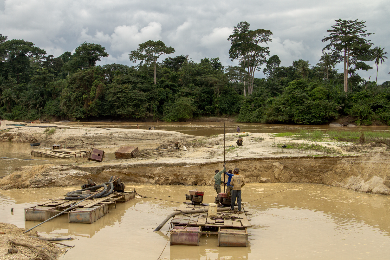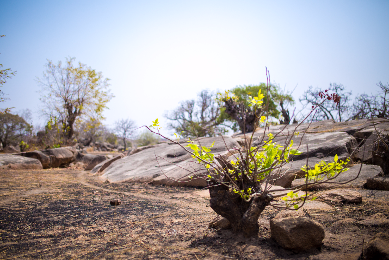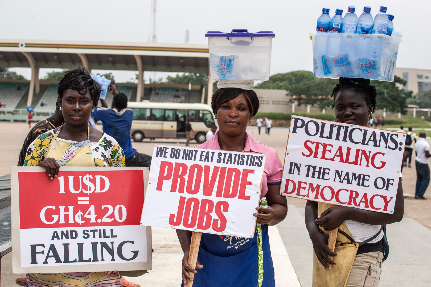The Project "Life of a Boabab"
"...it consisted of two districts in which one lived scholars and business people and in the other
the king and his court. There were many gardens, the king lived in a sumptuously -furnished castle with glass windows. Farmers irrigate their fields, and drew water from forti-fied freshwater wells.
Gold was in abundance, the king raised taxes and road tolls according to fixed tariffs, and there was an administration, which controlled the goods…"
El Bekri – Founded letter of the description of an Arab Businessman, of the capital of the Empire of Gana in the
11th century (today´s region of Mali)
Situation
Africa is considered to be the cradle of mankind and impresses with it deserts, the Nile as longest river on earth, its huge lakes and mountains as a continent of geographical wonders. Approximately 850 million people live in 54 countries in Africa with more than 6,000 different ethnic groups, and more than 8,000 languages and countless cultures with various festivals, customs, political and economic organization forms, beliefs, rituals, arts etc.
The converse to this colorful reality prevails an unbroken negative image about Africa in Western civilizations until today. The perception of misery, disease, disasters, dangerous, history- and cultureless, uncivilized dominates the media and perception of Africa of most people. Furthermore, the knowledge of the enormously rich and complex political, social and cultural reality of Africa is still destitute.
The bad image and perception of Africa in Western “civilizations” unbroken until today because of the powerful after -effects of stereotypes, prejudices and clichés against Africa since colonial times, which are still maintained and supported by some Western community -leaders, personalities, scientists, the mass-media etc. as mentioned above.
Stereotypes obviously affect the interpersonal communication and relationships of every human being. Consequently, those clichés still exist today and reflect a structural discrimination against Africans and black people worldwide. At the ame time prejudices ignore and a neglect the continent Africa and its huge potential (tourism, products, workmanship, culture etc.) in times of globalization.
Morten Kjaerum (Director of the EU Fundamental Rights Agency - FRA) concluded: “The official figures on racism, such as racist crimes and nuisances in the EU are just the tip of the iceberg” because many negative experiences are still not reported.
The USA, a country and society with a long tradition of immigrants from different parts of the world, still shock with racial profiling, affirmative action, police brutality against black Americans and other minorities - after decades of their written human rights pacts based on the history of slavery.
Trayvon Martin, Michel Brown, Eric Garner, Walter Scott, and the Charleston church shooting, are only some examples of current incidents of excessive violence and racism against black Americans in the United States which has been a major issue since the slave era. Racial politics remain a major phenomenon. Racism continues to be revealed in indirect forms of expression and occurs in employment, housing, education, lending, legal and government.
After the feat of voting for the first black president of the USA, Barak Obama, yet, America experiences a different atmosphere. Donald Trump a conservative billionaire and leading candidate for the Republican Party to run for the presidential election in 2016, announced that he is going to “make America great again.”
Xenophobic and racist hate -speeches against ethnic and racial minorities surprisingly attract the attention of the media and people in America, by exploiting white Americans’ fear of “the other”, “the stranger”, and the un-normal” based on a lack of knowledge and tolerance.
The above examples represent an incredibly tiny number of incidents demonstrating the stand and rise of racism in Europe and America which constitutes to be far from being a marginal activity. Racism and violence against ethnic minorities has become the daily routine in some communities.
Differences with other cultures are not seen as inspirational and enriching, but reinterpreted as inferiority and subservience.
The Idea and Aim
Therefore it is necessary to oppose and correct this poor knowledge, wrong pictures and the attitudes and behavior as well to create new communication- and relation-networks to other cultures - especially to the cultures of Africa, where the knowledge (surprisingly in times of mass-media, YouTube, Google, Facebook etc.) is still very poor.
In the study of the Criminal Research Institute of Lower Saxony “Youth in Germany as victims and Perpetrators of Violence” Christian Pfeiffer announced that: “The xenophobia is higher in those regions where only few foreigners live. Where the direct experience is lacking with the stranger, exist the greatest prejudices”.
The former Secretary General of the Council of Europe, Terry Davis, said, “Governments could not force people to tolerance. However, they should implement dialogues of religions, ethnic groups and people of different color”.
The project "Life of a Baobab", with:
- the production of the musical " Diary of a Lost Baobab" and its film production
- the book publication of Anthology Africa – “Notes of a Baobab”,
- and the information- and art-exhibition
should spark discussions on fim festivals, socail media, workshops and other forums in order to raise awareness, create an open dialogue about a different approach about the African reality and cotribute to a debate on "culture and development". It should also close another the gap to insights and knowledge of “the strangers” of Africa. It is an invitation to a journey to “the strange” of the cultures and histories of Africa.
“The world is a book. Who do not travel read only one side of it”
Aurelius Augustinus
Final, the positive examples of pushback need to be mentioned, like the welcoming-culture, solidarity for refugees and migrants and the enormous demonstrations against racist protests and movements.
The Musical piece attempts to -in opposite to the western civilization widespread “dark” and negative image as well often associated ”romanticizing good mood musical productions”- show a different perspective of Africa.
Here, the viewer embarks not only on the journey in other cultures and with that to a “different self-evident” but rather also -through a cultural comparison and own cultural questioning- a journey to himself.
“Everything that irritates us about others can lead us to an understanding of ourselves.”
Carl Gustav Jung
The view and examination of different facets of Africa – religion, tradition, history, conflicts, nature, love, rites, politics, education, believes, customs, social interaction etc. – performed in this artistically description (musical “Diary of a lost Baobab” and its film-production) demonstrate a perspective of a breath of experience of “Africa” as well as the attempt that life and living together can have many different imaginings and ways. The engagement leads to self-questions and the examination of current concepts of how we perceive history, other cultures, intercultural learning and relation, development, our own culture and our matter of course ...at it happened to me.
The Baobab Tree
The baobab is surrounded by a rich web of mystique, fables and fantasy in many ways in Africa. Bare branches look similar to roots; the whole plant resembles a root-system, which is the reason for the habitual description “upside-down tree”. It is a tree that can provide food, water, shelter and relief from illness.
The baobab tree with its hollow stems is strong and has been used by people for ages for various purposes like houses, prisons, pubs, storage barns or bus stops. The baobab works as a vital reservoir of water for people and animals during the dry seasons of the year. The fibrous bark is lax, soft and flexible, and is used to make various valuable articles such as mats and cords, fishing nets and lines, bags as well as clothing. Particular compounds isolated and extracted from the bark in order to manufacture soap, glue or rubber.
The fruit of the baobab, which can be consumed fresh or dried, contains the vitamins C and A as well as minerals such as iron, calcium, and potassium. The pulp can be mixed with milk or water, is processed as an ingredient of porridges and for various alcoholic and non-alcoholic beverages.
The baobab is also be used as medicine to facilitate digestion, reduce fever and improve and support the function of the nervous system. Even the roots and sprouts of young trees are used to provide food. The leaves, being rich in vitamin C, sugars, potassium tartrate, and calcium, are cooked fresh as a vegetable or dried as powder as an important part of the diet.
The seeds of the baobab tree are also edible and can be roasted in order to provide a substitute for coffee. In combination with the pulp they can be used as a thickener of jams and gravies as well. A baobab tree can survive for more than three thousand years.
Considering the diverse possibilities of use and the enormous span of life it becomes obvious why the baobab is called the “tree of life” and its humble appearance constitutes the main reason for us to select it as the colorful metaphor and witness for African cultures in general.




